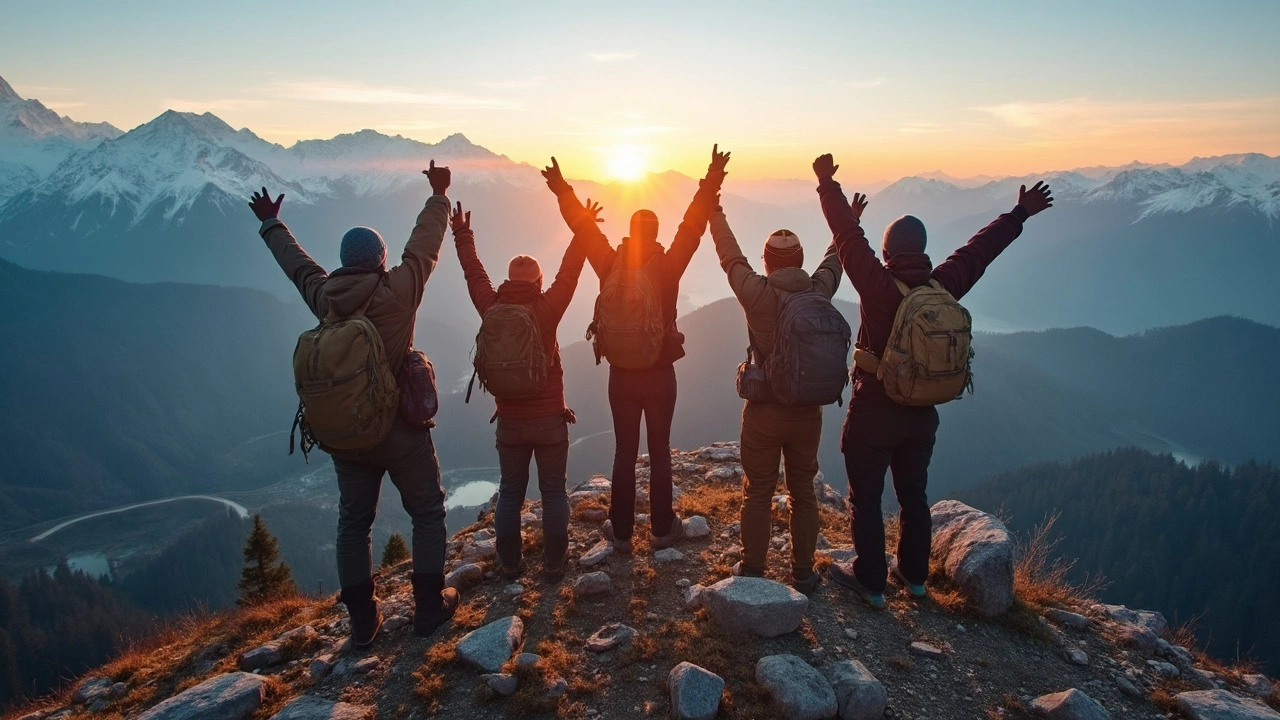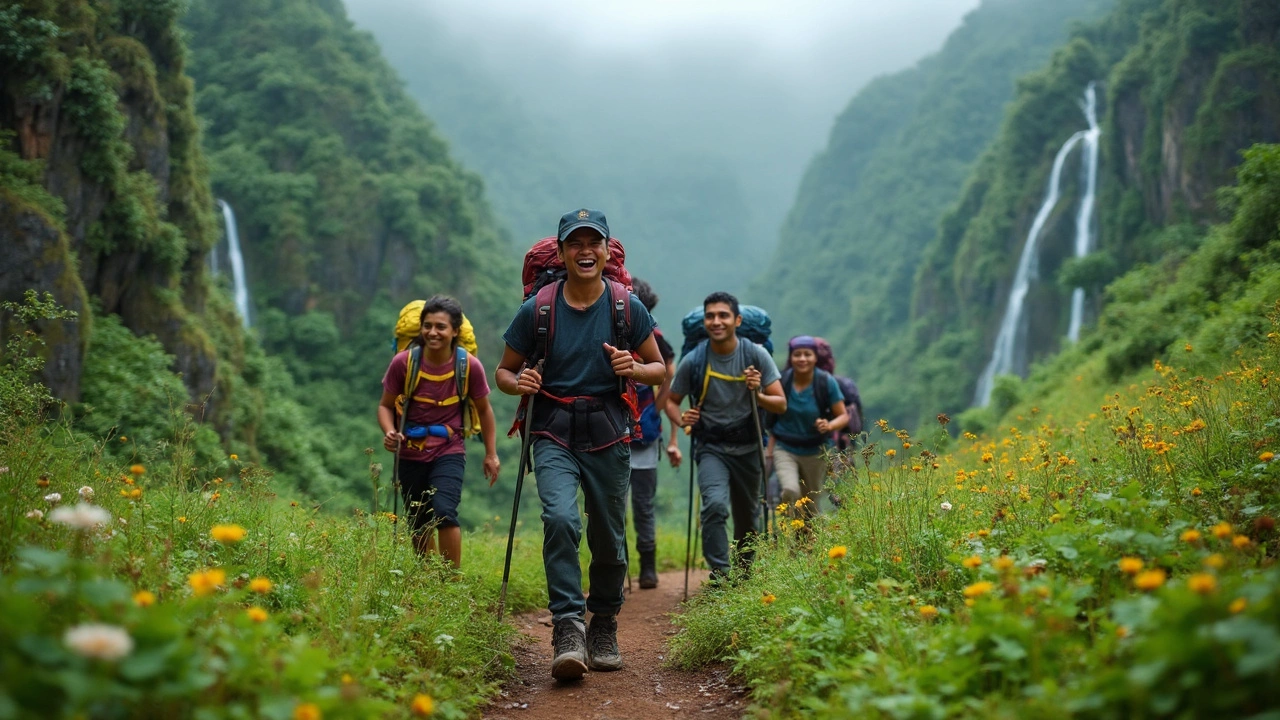The word 'variety' barely does justice to India's hiking scene. One minute you're sweating through pine forests in Himachal Pradesh, and the next you’re crossing red desert dunes in Rajasthan or tracing ancient trade routes in Sikkim. This country throws everything at you—snow, jungles, rivers, and valleys so dramatic you'll blow up your phone storage with photos.
Some places, like the Chadar Trek up in Ladakh, even dare you to walk on thick ice during winter. On the opposite end, you’ve got trails like Kudremukh in Karnataka, where you hike through rain-soaked, rolling green hills and might bump into wild bison or spot dozens of waterfalls. You don't need to be a hardcore climber for most Indian treks either—plenty are beginner-friendly, and, for the daredevils, some are so tough they’ll leave your legs begging for mercy.
- Why India Pulls in Hikers
- Must-Know Trekking Spots
- Best Time and Season Tips
- Practical Trekking Advice
Why India Pulls in Hikers
India’s got something for every kind of trekker. It isn’t just the size of the country—it’s the insane range of landscapes. From the snowy peaks of Kashmir to the jungles of the Western Ghats, the experience isn’t one-size-fits-all. You get trails at every elevation, every climate, all year round. That explains why India trekking attracts everyone from weekend hikers to serious mountain climbers.
Look at the Himalayas—they stretch across five Indian states and serve up some of the world’s most famous trails, like the Markha Valley trek or the Annapurna Circuit (on the Nepal side, but Indian routes link up). For those after culture, hikes like the Valley of Flowers or Kheerganga put you smack in the middle of local traditions, mountain villages, and ancient myths. You aren’t just hiking, you’re soaking up a slice of history and culture every time you stop to catch your breath.
There’s more. Most of the best hiking destinations in India are affordable compared to Europe or North America. You can hire local guides, stay in homestays, and eat hearty meals without burning a hole in your wallet.
If numbers get you going, here’s something solid—India has eleven official mountain ranges and more than 100 major trekking trails recognized by state tourism boards. Plus, according to the Adventure Tour Operators Association of India, about 1.2 million tourists signed up for trekking adventures in 2023 alone.
| Region | Popular for | Best Season |
|---|---|---|
| Himalayas | Snow treks, altitude climbs | Late spring, autumn |
| Western Ghats | Rainforest hikes, waterfalls | Monsoon, early winter |
| Eastern India | Bamboo forests, valleys | Post-monsoon |
At the end of the day, it all comes down to this: Few countries make it this easy to mix natural beauty, adventure, and culture in one big, sweaty, breathtaking package. So if you’re bored of the same old trails, trekking tips for Indian adventures can easily make your bucket list a whole lot longer.
Must-Know Trekking Spots
If you check out any list about India trekking, you’ll see the Himalayas hog most of the attention—and honestly, for good reason. Some of the world’s best trekking destinations are up there. But don’t get tunnel vision, because south and west India have some wild trails too. Here’s a straight-up guide to places you shouldn’t miss if you’re serious about racking up those hiking miles.
- Chadar Trek (Ladakh): Only happens in January and February, when the Zanskar river freezes and you literally walk on ice. Temperatures dip well below -15°C (yup, pack more than one jacket). It’s famous for wild ice cliffs and, weird as it sounds, frozen waterfalls. Not for first-timers, but it’s a bucket-list trek for pros.
- Valley of Flowers (Uttarakhand): Super popular between July and September, when the whole valley explodes with blooming flowers—over 600 species! This trek is good for beginners and is inside a national park, so the scenery is always top-tier. Watch out for altitude though, as you’ll hit 3,600 meters.
- Markha Valley (Ladakh): Runs through quaint villages, old monasteries, and those vast, open Himalayan views. If you want a taste of local culture while hiking, this is your route. The trek goes up to 5,200 meters, so spend a few days acclimatizing in Leh before starting.
- Sandakphu (West Bengal/Sikkim border): This one’s a show-off. On a clear day, you can see four of the world’s five highest peaks—Everest, Kangchenjunga, Lhotse, and Makalu—all lined up. The hike’s not too difficult and takes about 4-6 days.
- Kudremukh (Karnataka): Way down south, this is the prettiest green you’ll ever see. The name means ‘horse face’ in Kannada, and if you squint at the main mountain, you’ll see why. Trekking here requires a permit because it’s a national park—watch for leeches during monsoon!
If you’re into numbers, here’s a quick look at altitude, best season, and difficulty for these trails:
| Trek Name | Altitude | Best Months | Difficulty |
|---|---|---|---|
| Chadar Trek | 11,150 ft | Jan-Feb | Hard |
| Valley of Flowers | 11,800 ft | July-Sept | Easy-Moderate |
| Markha Valley | 17,060 ft | June-Sept | Moderate-Hard |
| Sandakphu | 11,930 ft | Oct-Dec, Mar-May | Moderate |
| Kudremukh | 6,207 ft | Oct-Feb | Easy-Moderate |
One tip—always double-check permits before planning. National parks like Valley of Flowers and Kudremukh are strict about entry. Up north, solo trekking sometimes isn't allowed without registering with local authorities, especially in the border regions. Don't ignore altitude sickness either; take it slow, drink loads of water, and listen to your body. Each of these hiking destinations gives you something different, so pick your flavor and lace up your boots.

Best Time and Season Tips
If you want to get the most out of India trekking, timing isn’t just important—it’s the secret sauce. The country’s got just about every climate zone packed inside its borders, so when you travel matters as much as where you travel.
Here’s something a lot of first-time trekkers miss: The best season isn’t the same everywhere. Most famous Himalayas treks happen March to June or September to November. Monsoon hits the north between July and August, turning trails slippery and sometimes dangerous. But go south and the Western Ghats—like Kerala or Karnataka—come alive during the monsoon (June to September). Sure, you’ll get soaked, but those hills are at their greenest and you’ll see waterfall action that’s off the charts.
- Summer Treks (March-June): Perfect for Himalayan routes. Snow’s melted, weather’s mild, and views are unreal. Try Kedarkantha or Hampta Pass during this window.
- Monsoon Treks (July-September): Skip the north, but check out the Western Ghats. Trails like Valley of Flowers hit their peak bloom in August.
- Autumn Treks (September-November): Clear skies, great weather for the Himalayas, and the crowds are thinner. Roopkund Lake trek is a top pick.
- Winter Treks (December-February): Ready for snow? Some lower-altitude treks like Nag Tibba are hikeable, while the Chadar Trek across frozen river in Ladakh is only possible now.
The quick takeaway: Always check the weather and trail conditions before you lock in plans. If you’re set on a specific trail, Google the best season for it—don’t just guess. And pack for sudden weather changes: even summer in the Himalayas can turn icy by sunset.
| Region | Best Months | Popular Treks |
|---|---|---|
| Himalayas (North) | Mar-Jun, Sep-Nov | Hampta Pass, Kedarkantha, Roopkund |
| Western Ghats (South/West) | Jun-Sep | Kudremukh, Tadiandamol, Rajmachi |
| Ladakh/Zanskar | Jan-Feb (Winter Trek) | Chadar Trek |
Bottom line: Pick your season based on the region and trail. That’s how you get an unforgettable India trekking experience—not a soggy hike gone wrong.
Practical Trekking Advice
No matter how chill or epic your India trekking plans are, you’ll want to avoid the classic rookie mistakes. India’s hiking routes can change a lot by the season – what’s a cool stream now could be dragon-hot sand in May, or a snowed-in path by January. Double-check trail status before you pack. Sites like Indiahikes or the Ministry of Tourism’s updates are way more reliable than old travel blogs.
Pack smart, and go light. If you’re hitting the Himalayas treks, you absolutely need layers. The weather flips out between sun and hail in a single day. For spots in the Western Ghats or during monsoon, a rain jacket is worth its weight in gold. Local guides often make all the difference: they know the region, can point out shortcuts (or when to avoid "easy shortcuts"), and even help in emergencies. Don’t try to tough it out solo if you’re new to the region or have zero navigation skills.
Here’s a simple gear checklist for most India trekking trips:
- Lightweight backpack, 35-50L
- Sturdy shoes with solid grip (don't cheap out)
- Thermals, windproof jacket (for Himalayan treks)
- Raincoat or poncho (especially south and during June-Sept)
- Reusable water bottle (and purification tablets if you’re remote)
- Basic first-aid kit
- Snacks and high-calorie food (local trail mix or "chikki" is a good hack)
- Power bank and small flashlight/headlamp
Don’t mess with altitude sickness. If you’re going above 2,500 meters, plan for at least one easy day to help your body adjust. Hydration is key – and so is skipping alcohol until you’re back at base. Indian mountains have basic but helpful teahouses or guest huts on popular routes. Places like Himachal or Uttarakhand let you go hut-to-hut, so you don’t need to lug a tent. But the farther you go off-grid, the more self-sufficient you need to be.
Ready for some quick stats? Here’s a peek at average daily trekking costs as of 2025:
| Region | Guide Cost (INR/day) | Food & Stay (INR/day) |
|---|---|---|
| Himalayas (Uttarakhand/Himachal) | 2,500–3,500 | 800–1,200 |
| Western Ghats | 1,800–2,500 | 500–900 |
| Ladakh | 3,000–4,500 | 1,200–2,000 |
Last tip: respect local rules. Don’t litter, avoid loud music, and ask before clicking photos in small villages. You’ll stay on the right side of locals—and the forest rangers. Your hiking destinations will thank you for it, and so will every traveler who follows your path.
